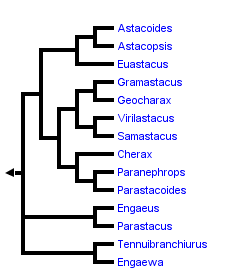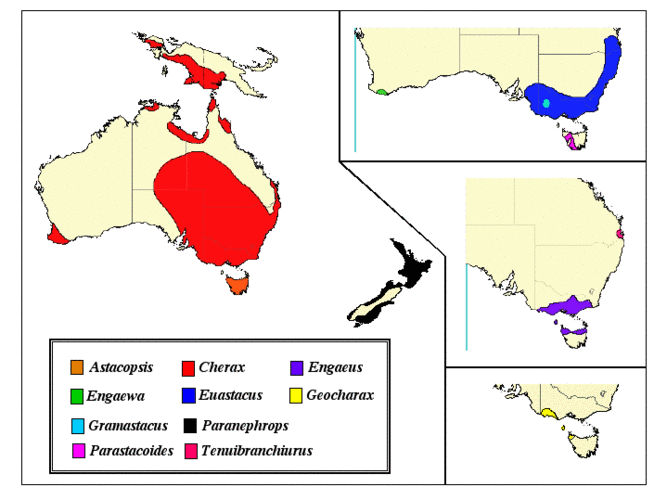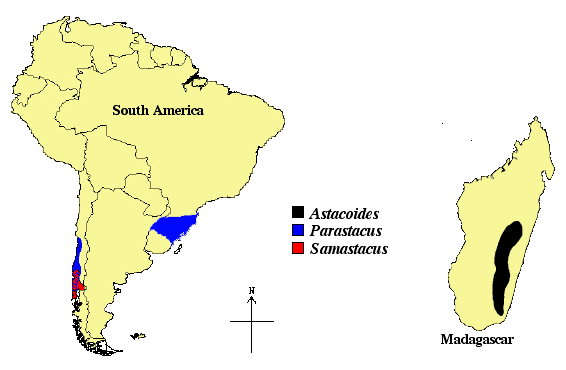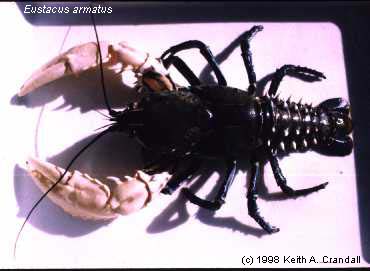Parastacoidea
Parastacidae
Keith A. Crandall


This tree diagram shows the relationships between several groups of organisms.
The root of the current tree connects the organisms featured in this tree to their containing group and the rest of the Tree of Life. The basal branching point in the tree represents the ancestor of the other groups in the tree. This ancestor diversified over time into several descendent subgroups, which are represented as internal nodes and terminal taxa to the right.

You can click on the root to travel down the Tree of Life all the way to the root of all Life, and you can click on the names of descendent subgroups to travel up the Tree of Life all the way to individual species.
For more information on ToL tree formatting, please see Interpreting the Tree or Classification. To learn more about phylogenetic trees, please visit our Phylogenetic Biology pages.
close boxIntroduction
The family Parastacidae contains all freshwater crayfish found naturally occurring in the southern hemisphere. Although widespread, with representatives occurring in South America, Madagascar (Fig. 2), and New Zealand, the family achieves by far its greatest diversity within Australia (Fig. 1). Over 85% of the known species of parastacid crayfish are from Australia. Similarly, nine of the 14 genera presently recognized within the Parastacidae are restricted to the Australian continent and nearby islands (including southern New Guinea) (Hobbs, 1988; Hobbs, 1991). The Australian freshwater crayfish fauna is unique and highly diverse, both in terms of species richness and in ecological and morphological diversity. This fauna contains the largest known freshwater invertebrate (Astacopsis gouldi [Clark]) and the highly evolved "land crayfishes" (e.g. Engaeus) which are able to complete their entire life cycle independent of surface water. In terms of the number of species, morphological variability, and ecological diversity, Australia's freshwater crayfish fauna is rivalled only by that found in the south east of the USA (for examples of Australian crayfish diversity, see Merrick, 1993).


Figure 1. Distribution of the 10 Australian Parastacid genera (from Hobbs 1988).

Figure 2. Distributions of the remaining Parastacid genera. Note that there is an overlap of Parastacus and Samastacus in central Chile that is not depicted very well in the graphic.
Discussion of Phylogenetic Relationships
Studies of phylogenetic relationships among genera of parastacid crayfish to date have been of limited scope (Riek, 1969; Riek, 1972; Patak & Baldwin, 1984; Patak et al., 1989; Austin, 1995; Crandall et al. 1995) and have produced conflicting results using a variety of approaches and data sets. Riek (1969) presented the first systematic hypothesis for the relationships among the Australian genera (presented here). This hypothesis was based on features of the male genitalia, cephalothorax, and chelae as well as body shape (Riek, 1969). Subsequent to this study, Riek (1972) proposed an alternative interpretation with the additional characters associated with the cephalothoracic grooves and orientation of the chelae. This latter hypothesis added the genera Gramastacus and Paranephrops to the phylogeny and shifted the association of Parastacoides from the Euastacus-Astacopsis clade to the Cherax clade.
The two major clades proposed by Riek (1972) form two ecologically distinct groups; Engaeus, Engaewa, and Tenuibranchiurus form the first group, representing strong burrowers in which the fingers of the chelae move in a vertical plane; Euastacus, Astacopsis, Gramastacus, Geocharax, Parastacoides, Paranephrops, and Cherax comprise the second group of moderate burrowers in which the fingers of the chelae move largely or completely in a horizontal plane.
Patak and Baldwin (1984) applied electrophoretic and immunochemical comparisons of haemocyanins to infer phylogenetic relationships among a subset of the Australian genera. These biochemical techniques generated a hypothesis that differed from that of Riek (1972) in that the Geocharax-Gramastacus clade was clustered with the genus Engaeus instead of within Riek's ecological group two. Patak et al. (1989) later added two additional genera to their study (Parastacoides and Paranephrops) resulting in a phylogeny that differed in the placement of Cherax and Euastacus. Using a goodness of fit test in association with the immunochemical data, Patak et al. (1989) rejected their previous tree as well as the hypothesis of Riek (1972), concluding these were incompatible with their new data set.
Austin (1995) proposed a sister relationship between Cherax and Geocharax based on allozyme data (24 enzymatic loci) and morphological data (55 characters, including most traits previously emphasized by Riek [1969, 1972] and Hobbs [1989]). Treating the morphological data and allozyme data as independent data sets, Austin (1995) obtained support for the clustering of Cherax with Geocharax in both cases. Finally, Crandall et al. (1995) reconstructed phylogenetic relationships for representatives of various Australian genera using nucleotide sequence data from the 16S mitochondrial genome. The resulting tree was statistically incompatible with the hypotheses proposed by Riek and the Patak and Baldwin hypothesis. However, the results were compatible with the Patak et al. (1989) and the Austin (1995) hypotheses. For a summary of these alternative hypotheses see Crandall et al. (1995). Because none of these studies have included all the genera found in Australia (not to mention in the family Parastacidae) the tree shown is Riek's (1969) with the additional southern hemisphere genera included with relationships suggested by Hobbs (1988;1991).
References
Austin, C.M. 1995. The definition and phylogenetic position of the genus Cherax (Decapoda: Parastacidae). Freshwater Crayfish 8:12-31.
Crandall, K.A., Lawler, S.H. and Austin, C. 1995. A preliminary examination of the molecular phylogenetic relationships of the crayfish genera of Australia (Decapoda: Parastacidae). Freshwater Crayfish 10:18-30.
Hobbs, H.H., Jr. 1988. Crayfish distribution, adaptive radiation and evolution. Pp. 52-82 in D.M. Holdich and R.S. Lowery (eds), Freshwater crayfish: biology, management and exploitation. Timber Press, Portland.
Hobbs, H.H., Jr. 1991. A new generic assignment for a South American crayfish (Decapoda: Parastacidae) with revised diagnoses of the South American genera and comments on the Parastacid mandible. Proceedings of the Biological Society of Washington 104:800-811.
Horwitz, P. 1995. A preliminary key to the species of Decapoda (Crustacea: Malacostraca) found in Australian inland waters. Co-operative Research Centre for Freshwater Ecology, Albury, Australia.
Merrick, J.R. 1993. Freshwater crayfishes of New South Wales. Linnean Society of New South Wales, Milson's Point, N.S.W.
Patak, A. and Baldwin, J. 1984. Electrophoretic and immunochemical comparisons of haemocyanins from Australian fresh-water crayfish (Family Parastacidae): Phylogenetic implications. Journal of Crustacean Biology 4:528-535.
Patak, A., Baldwin, J. and Lake, P.S. 1989. Immunochemical comparisons of haemocyanins of Australasian freshwater crayfish: Phylogenetic implications. Biochemical Systematics and Ecology 17:249-252.
Riek, E.F. 1969. The Australian freshwater crayfish (Crustacea: Decapoda: Parastacidae), with descriptions of new species. Australian Journal of Zoology 17:855-918.
Riek, E.F. 1972. The phylogeny of the parastacidae (Crustacea: Astacoidea), and description of a new genus of Australian freshwater crayfishes. Australian Journal of Zoology 20:369-389.
Title Illustrations

Euastacus armatus (von Martens)
Photo copyright © 1998 Keith A. Crandall
| Copyright |
© Keith A. Crandall

|
|---|
About This Page
Keith A. Crandall

Brigham Young University, Provo, Utah, USA
Page copyright © 1995 Keith A. Crandall
 Page: Tree of Life
Parastacoidea. Parastacidae.
Authored by
Keith A. Crandall.
The TEXT of this page is licensed under the
Creative Commons Attribution-NonCommercial-ShareAlike License - Version 3.0. Note that images and other media
featured on this page are each governed by their own license, and they may or may not be available
for reuse. Click on an image or a media link to access the media data window, which provides the
relevant licensing information. For the general terms and conditions of ToL material reuse and
redistribution, please see the Tree of Life Copyright
Policies.
Page: Tree of Life
Parastacoidea. Parastacidae.
Authored by
Keith A. Crandall.
The TEXT of this page is licensed under the
Creative Commons Attribution-NonCommercial-ShareAlike License - Version 3.0. Note that images and other media
featured on this page are each governed by their own license, and they may or may not be available
for reuse. Click on an image or a media link to access the media data window, which provides the
relevant licensing information. For the general terms and conditions of ToL material reuse and
redistribution, please see the Tree of Life Copyright
Policies.
- First online 01 June 1995
- Content changed 05 October 1999
Citing this page:
Crandall, Keith A. 1999. Parastacoidea. Parastacidae. Version 05 October 1999 (under construction). http://tolweb.org/Parastacidae/6665/1999.10.05 in The Tree of Life Web Project, http://tolweb.org/







 Go to quick links
Go to quick search
Go to navigation for this section of the ToL site
Go to detailed links for the ToL site
Go to quick links
Go to quick search
Go to navigation for this section of the ToL site
Go to detailed links for the ToL site